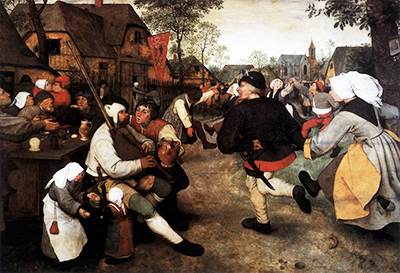Peasant Dance was painted by Bruegel around 1569 as an oil on panel.
It is currently held by the Kunsthistorisches Museum in Vienna. The painting is not signed or dated but it is deemed likely that it was either part of a series or paired with Bruegel's Peasant Wedding.
Both paintings were created around the same time and are the same size.
In typical Bruegel style, the lively peasant scene provides the viewer with a glimpse of social history.
Each figure in Peasant Dance is caught in action, feasting, drinking, dancing, chatting and possibly about to fight.
The figures running towards the centre of the picture in particular, provide a real sense of life and movement within the piece. However, like so many of Bruegel's images, Peasant Dance may provide much more than a local scene.
Some historians have discussed the possibility that Bruegel was also commenting on moral issues and have identified issues which seem to point towards some of the seven deadly sins.
The man sitting next to the bagpipe player wears a peacock feather in his hat an outward sign of vanity. Despite the setting being a Saint's Day, the peasants show no interest in the religious symbols, turning their backs to the church and enjoying the dancing and drinking instead.
One couple is clearly kissing, some of the men appear to be arguing. Perhaps Bruegel was also depicting elements like greed, lust and aggression.
Comments have also be made about how the peasants are portrayed compared to how nobility would have been shown. The dancers are lively as if skipping, unlike the careful court dances of the day and the ruddy, glazed faces are "natural", with all imperfections on show.
Peasant Dance is a wonderful picture which captures Bruegel's wit and provides the viewer with a feast for the eyes.




